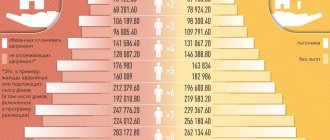Home » Division of property » Division of a land plot into two
3
The need to divide a land plot is not such a rare procedure as it might seem at first glance. Divorce of spouses, inheritance of one property by several persons, desire or need to sell part of the land - these are just some of the reasons to divide the land plot into two independent ones. With such a division, it is not so much the reason for the procedure that is important, but the need to carry it out correctly, including the preparation of all the necessary documents both for the division itself and for the subsequent registration of ownership of each secondary object.
Is it possible to divide a plot of land into two?
According to the Civil Code of the Russian Federation, most real estate objects are indivisible and are not subject to real division. This primarily applies to residential premises in apartment buildings, some types of individual residential buildings, as well as land plots of certain categories. But not everyone. For example, a plot intended for individual housing construction, especially if there is a house for two owners, or for gardening can be divided if certain criteria are met.
Regardless of the possibility or impossibility of a real division of a real estate property, any real estate that is in shared ownership can be legally divided.
Moreover, even if actual division is possible, the procedure for its legal division must necessarily precede it. In other words, in any case, a legal division is carried out first, then, after the shares of each of the co-owners have been determined, the division of the object in kind can begin according to the shares of each of the co-owners.
If there is a residential building on the plot of land intended for division, it is divided first, only then, depending on what part of the house each of the co-owners will receive during division, the land near the house will be divided. In practice, each of the co-owners receives that part of the plot that is adjacent to his half of the residential building.
This rule is applied due to the more complex procedure for the actual division of a residential building, since each owner is required to have a separate entrance, and this is technically difficult. It’s much easier to add soil.
Features of the division of land
The purpose of any division of land is the formation of new independent plots, independent of the original and each other. After this procedure, the original (primary) land plot is abolished, and in its place new, smaller objects are formed, each of which has all the signs of independence.
However, after the formation of two separate objects, both co-owners of the primary allotment still have the right of joint ownership of them.
To divide the land into two parts, the following conditions must be met:
- The purpose of the newly formed objects must remain the same as the original one.
- The size of each of the secondary plots cannot be less than the minimum allowable for a given category of land in a given region.
- Each of the newly formed plots must have free access for vehicles and pedestrians.
- Land intended for peasant farming is not divided under any circumstances, since there is a legal ban on the division of land in this category.
Legal section
Any real estate may have one or more owners (common shared ownership). Most often, common shared property arises after the acceptance of an inheritance by several heirs or after a divorce. As a result, the land plot has two co-owners, and while the shares of the heirs may be different, for the former spouses they are recognized as equal, 50% each. But the land plot is still a single object with one cadastral number and address.
The procedure for legal division of a land plot depends on the situation. The division of land between former spouses is possible according to two options, namely:
- As a result of a voluntary agreement certified by a notary office. Such a document is the basis for issuing a certificate of ownership of half of the land plot.
- According to the court . Division based on a court decision occurs in cases where co-owners cannot reach an agreement.
The division of a land plot received by inheritance occurs on the basis of a certificate of inheritance and is carried out according to the inherited shares.
In accordance with the Civil Code of the Russian Federation, all co-owners of a real estate property have the right to dispose of their shares without restrictions, the share can be:
- sold;
- donated;
- bequeathed.
The only difference when disposing of shares of an allotment from the whole is that, according to the Civil Code of the Russian Federation, the co-owner of the property has a preemptive right to acquire it.
Division of land in kind, methods and obstacles
If the co-owners of the land have normal relations with each other, then such a legal division is usually enough to divide the plot between the owners. But in practice, it is not always applicable, especially if strained relations have been established between the co-owners. The land plot still remains a single object, which means that many actions on the plot require the consent of all its owners.
For example, one of the co-owners wants to plant an orchard on the property, but the second does not need such a garden, he wants to plant vegetables and potatoes. Either one of them wants to carry out land reclamation and drain the swamp in the center of the plot, and the second, on the contrary, wants to deepen this swamp and equip a pond with fish there. As long as they are the owners of shares of a single plot of land, each of them will not be able to realize their plans.
That is why most owners of land shares seek to transfer their half of the plot into real independent land plots. Really, there are two options:
- in accordance with a voluntary agreement on the use of land;
- by allocating a share of the plot in kind.
Each of the options has both advantages and disadvantages, but there are currently no other methods of dividing a land plot.
Section stages
The division of a land plot occurs in several stages:
- Coordination of land surveying with all co-owners; for this it is necessary to obtain their written consent.
- Land surveying to determine the boundaries of the allotment. To do this, you need to contact an organization that has a license for this type of activity. Land surveying must take place in the presence of all co-owners or their representatives (with a power of attorney). All boundaries of the allotment are fixed with special boundary posts, then the areas of the initial and secondary allotments are determined, drawings are drawn up and the boundary work is formed.
- Drawing up a voluntary agreement on the division of land. The document must be certified by a notary office; this requirement is necessary in order to exclude in the future any illegal actions on the part of any of the parties to the agreement.
- In the absence of agreement between the owners, filing a statement of claim in court and subsequently receiving a court verdict (if its decision is positive).
- Assignment of separate addresses to each of the secondary plots. To do this, you need to visit your local municipality and write a corresponding application. It must be accompanied by a survey file, a cadastral passport for the primary plot, all title documents and a copy of a voluntary agreement or court order.
- Providing title documents to cadastral authorities and registering secondary plots for cadastral registration. Ten days after applying to Rosreestr, owners of newly formed plots receive cadastral passports for them.
- Registration of ownership of new real estate.
Cost of work
For each secondary plot, payment for cadastral work must be made. Thus, the cost of all land surveying work will be equal to the price of land surveying one plot, multiplied by the number of newly created ones. In each region, the cost of cadastral work is different, for example, in the Moscow region it is calculated as a percentage of the price of a land plot, and in the Central District it most often amounts to 7-8 thousand rubles per plot.
The impossibility of dividing the plot, as well as the conditions and procedure for its provision. Preemptive right
Most often, the impossibility of dividing a plot occurs when the plot is small in size and the division results in plots smaller than the permitted size. It is for this reason that citizens are refused to carry out this procedure.
Refusal may also occur if not all necessary documents are available for the land in question . The received refusal can be challenged, but this does not mean that the result will be positive.
The procedure on the basis of which agricultural land is provided for use is established by the legislation of our state. If agricultural land is in municipal or state ownership, it can be allocated to citizens exclusively for horticultural or agricultural purposes.
A citizen may have a land plot for indefinite use or be issued for a certain period . In the first case, the period of use of the land is not limited, in the second, the terms are clearly indicated in the relevant document.
Agricultural land can be provided to users both for joint use and for individual use. The plot can be provided either under a lease agreement or as a property.
In the case of a lease, all the main points are indicated in the contract, including the types of land use, the preemptive right and other nuances are necessarily indicated.
The legislation has outlined a number of parameters for the acquisition of land that is in state or municipal ownership, and preemptive rights are prescribed for certain categories.
This right means the possibility of speeding up the procedure for purchasing a land plot. This right applies, for example, to owners who have unfinished construction projects. The peculiarity of this right is that it cannot be inherited.
Video: How to divide a plot of land?
How to divide a plot of land into two plots through the court
The division of land becomes significantly more complicated if the owners cannot agree on the procedure or the whereabouts of one of the co-owners is unknown (it is not possible to obtain his consent to the division).
The first step when dividing through the court is to draw up and submit a statement of claim.
Form and content of the claim
Such a procedural document as a statement of claim must strictly comply with the requirements for such documents by the Civil Law Code of the Russian Federation.
It must be borne in mind that if the court discovers inaccuracies, errors, inconsistencies and other violations, the court leaves the claim without progress and returns it to the plaintiff for revision, which significantly delays the process.
The statement of claim must contain the following information:
- Details of the judicial authority to which the claim is filed.
- Personal data of the plaintiff and defendant, as well as third parties, if they are involved in the process.
- Title: “Statement of claim for division of land.”
- If former spouses are involved in the process, then information about when and where the marriage was registered and the same information about the divorce of the latter.
- All information about the disputed land plot: when it was acquired, on what grounds, its individual characteristics and description of buildings, if any.
- An indication of the reasons for the dispute and a list of those rights of the plaintiff that were violated by the defendant, as well as the impossibility of resolving the problem peacefully.
- Other circumstances of the case that may help in the legal process.
- Substantiation of the plaintiff's claims.
- Information about the secondary land plots that will be formed as a result of the division (their area, boundaries, presence of buildings or other objects on their territory).
- References to specific articles of the Law on the basis of which the plaintiff demands partition.
- Claim. First, the plaintiff writes the heading “I ASK”, then lists all the demands on the defendant.
- A numbered list of all attached documents.
- Date of filing the claim and signature of the plaintiff.
Sample statement of claim for division of land
The text of the statement of claim can be printed or written by hand; in any case, corrections, blots, and inaccuracies are not allowed. The application should not be vague, any discrepancies or allegories are not allowed, business style is required. When drawing up a claim, it is advisable to contact a lawyer who will help you write a document in accordance with all the requirements.
All documents listed in the claim (photocopies) must be attached to the statement of claim; the receipt for payment of the state duty is attached in the original. In each specific situation, the list of documents may be different, but some of them are required in any case, namely:
- Photocopies of passports of all parties to the process.
- Copies of documents on marriage and divorce.
- All title documents for the primary land plot.
- Technical, cadastral documents for the plot.
- A copy of a certificate from an independent appraiser about the cost of the property.
- Receipt for payment of state duty (original).
It is necessary to remember the jurisdiction of the case: the application is submitted to the district court at the location of the disputed plot of land.
State duty
In accordance with the Code of Civil Procedure of the Russian Federation, in order to file a claim in court, a citizen must pay a state fee. In this case, claims for the division of land plots are considered claims of a property nature; the amount of state duty for such claims is calculated depending on the price of the claim.
Many people mistakenly consider the value of the claim to be the value of the entire disputed property, but this is incorrect. The value of the claim is the value of the share of the property claimed by the applicant.
Table 1. Calculation of the state duty for a statement of claim for the division of land plots depending on the price of the claim.
| Property value, rub. | Deduction from the amount, rub. | Constant, rub. | State duty (percentage of property value, %) | State duty limit, rub. |
| Up to 20,000 | — | — | 4 | Not less than 400 |
| 20 001—100 000 | 20,000 | 800 | 3 | — |
| 100 001—200 000 | 100,000 | 3,200 | 2 | — |
| 200 001—1 000 000 | 200,000 | 5,200 | 1 | — |
| Over 1,000,000 | 1,000,000 | 13,200 | 0.5 | No more than 60,000 |
Let's sum it up
The legislator established that the owner has the right to divide the land owned by him. A division of jointly owned land can also be implemented. As a result, each co-owner will receive a separate share. The restrictions relate only to the minimum size and the actual possibility of such division. The procedure is carried out in a strictly established order, where each step is important. The division is carried out voluntarily or by court decision.
Read: How to remove obstacles to the use of land
Arbitrage practice
The judicial practice of dividing land plots is quite extensive, but most often there are claims for the division of land between spouses after a divorce and claims for the division of a land plot inherited by two heirs. Let's look at each of them with examples.
Example 1
Spouses Natalya and Ivan L. During their marriage, they bought a residential building with a plot of land measuring 15 acres intended for individual housing construction. After the divorce, each of the spouses wanted to stay in the house and use the land plot, and if they were able to divide the house by equipping two separate entrances, then they reached a dead end with the division of the land. Each of them wanted to use a more fertile plot near the house, I suggest that the opponent take the distant plot, which was not completely improved.
After much debate, Natalya filed a statement of claim in court demanding to divide the land, which was jointly owned by the spouses, while she offered to give her a more “tasty” piece of land, but smaller in area, and give her husband the fallow land “in the outskirts.”
The court, having considered all the circumstances of the case, made a decision: to divide the land plot owned by Natalya and Ivan L. on the rights of shared ownership in equal shares, 7.5 acres each, transferring to the former spouses half of the developed and half of the virgin plots of land.
Example 2
Two brothers Nikolai and Alexey K. inherited from their father a plot of land for individual housing construction with an area of 6 acres and an unfinished house. At the same time, Nikolai offered his brother to complete the house for joint use in the future as a dacha. Alexey proposed to sell the land along with the unfinished construction and divide the proceeds, since the plot is not subject to real division due to its small area.
To implement his plan, Alexey filed a statement of claim in court demanding the sale of the land plot and the subsequent division of funds equally between him and his brother.
At the court hearing, Nikolai categorically refused to sell the property, citing the fact that the land and the unfinished house were all that remained in memory of their father. But Alexey was adamant.
The judge offered the brothers the following division option: the land plot and the building remain the sole property of Nikolai, who, in turn, pays Alexey half the cost of the house and the land under it. The brothers agreed to this version of the division and signed a settlement agreement.
Practical features
When carrying out the procedure for dividing a land plot, you need to take into account some features that arise in practice:
- if there is only one owner, then he will be able to carry out the division at any time, but drawing up a cadastral plan will still be required;
- if the plot is received into joint ownership, for example, by inheritance, then shared ownership is first registered, and only then the division is made;
- the owner can apply for division at any time, there are no restrictions on this;
- If there is a technical possibility and the rules on the minimum size of the plot allow, the land can be divided into any number of parts.
The procedure seems complicated, but quite feasible. The main thing is to check whether the division is actually possible; the rest is, as they say: “a matter of technique.”
How to divide a plot of land into two plots by agreement of the parties
If the co-owners of the land plot can agree, then the division can be carried out by voluntary agreement. In this case, the agreement is drawn up in writing, signed by all participants and must be certified by a notary office. To draw up an agreement, you must have the following documents:
- title documents for the primary land plot;
- cadastral passport;
- a certificate from the municipality about the provision of separate unique addresses for secondary sites;
- written consent of each co-owner to divide the land.
The text of the agreement must contain the address and cadastral number of the primary plot. It is also necessary to describe the result that the object section will lead to.
The division can be made either in accordance with the shares of each of their owners, or according to any other scheme.
After the document is signed and certified by a notary, the primary land ownership ceases to exist, and two new independent secondary plots are formed in its place.
The division of a land plot is a rather confusing and often unpredictable procedure. Therefore, during the entire division process, it is necessary to remember and follow a number of recommendations:
- All actions under this section must be carried out in accordance with the Land Code of the Russian Federation.
- Unauthorized division at the request of one of the co-owners is unacceptable; the consent of all owners is required. In the absence of consensus, only a court can help, which will carry out the division strictly within the framework of the law, while respecting the rights of all interested parties.
- The first and mandatory stage of the procedure should be land surveying; it should be carried out by organizations that have a license for this type of activity.
FREE CONSULTATIONS are available for you! If you want to solve exactly your problem, then
:
- describe your situation to a lawyer in an online chat;
- write a question in the form below;
- call Moscow and Moscow region
- call St. Petersburg and region
Save or share the link on social networks
- FREE for a lawyer!
Write your question, our lawyer will prepare an answer for FREE and call you back in 5 minutes.
By submitting data you agree to the Consent to PD processing, PD Processing Policy and User Agreement
Useful information on the topic
18
Is an apartment purchased before marriage divided during a divorce?
Division of an apartment during a divorce is a standard process associated with the dissolution of...
1
How is maternity capital divided when spouses divorce?
Maternity capital is a state payment due to a woman after the birth of her second...
4
How to sell a car after inheriting
After receiving a certificate of inheritance, the new owner of the car is obliged to...
4
Relinquishment of property during divorce
Former spouses do not always agree to divide their joint property...
Are alimony debts inherited?
Payment of alimony is one of the main sources of income for...
1
Division of a dacha in case of divorce
During a divorce, it becomes necessary to divide the property that the spouses used in...










